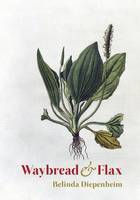Book Review: Waybread and Flax
- Anna Forsyth
- Oct 7, 2016
- 3 min read
Reposted with permission from Booksellers New Zealand.
You can view the original post here.
Posted on June 28, 2016

Available now in selected bookshops nationwide.
Suspending disbelief is something that Belinda Diepenheim has achieved in this clever and intriguing collection, an extension of the manuscript that won her the Kathleen Grattan Award in 2013. Employing the perspectives of the plant world is an ambitious decision, but one that Belinda achieves beautifully.
Plant perception is not a new idea. Even Darwin himself, after investigating climbing plants with his son, concluded that plants, albeit without neurons, can “…receive impressions from the sense-organs…” Some of the scenarios in Waybreadbring to mind the archetype of the blind prophet, such as the Bulgarian prophet, Baba Vanga and the idea of the silent observer to our chaos, who has vision, despite a lack of physical sight. Of course, this kind of outsider-looking-in narrative is great for exploring difficult subjects and giving the reader a taste of voyeuris
m without any added guilt. If offers us a fresh lens through which to see the world. All of this is tempered with a cheeky irreverence, such as the personification of horopito as a dangerous scarlet woman, the femme fatale of the plant world. ‘…hot through and through…”, Get too close, you might die…”
But it’s not all fun and games. Using the narrative device throughout the book enables Belinda to explore observations on colonisation, war and other difficult aspects of history, such as epidemics, through the eyes of the alien (the plant). The other benefit of using this device is that we also get to delve into the rich poetic soil of the botanical world, accompanied by gorgeous full colour plates of botanical illustrations. The title characters, waybread and flax are indicative of some of the subject matter – Waybread being the European import and flax, the symbol of New Zealand indigenous culture. The book is also divided into sections relating to ancient herbal cures. Cook and his imports and also Maori traditional medicines. It is no mistake that Belinda has chosen to focus on the healing and medicinal aspects of plants. The inference here is that, despite the brutality and trauma of our history, both colonisers and indigenous have an incredible potential for healing and co-habitation.
One thing you notice when making your way through the poems is that rain makes a regular appearance in nearly every poem. What could be more symbolic of healing the land? Again, it is woven throughout so as to seem inconsequential, but shows the deft hand of the poet in weaving it through the work. By the last poem, Solanum Laciniatum, Poroporo, we are left with the idea that just like that healing water that ebbs and seeps through “roots, stomata and shoots…”, we too are just passing through. Belinda comments that the next generation will still have:
…their hearts set on land of their own a mass of dreams that has nothing to do with reality.
Ultimately, the book ends on the note that it is enough to stand beside, to recognise our lack of ownership and the fleeting nature of our existence.
I stand beside, the tree ferns in the gully below, the fickle piwakawaka flying between bush lawyer and supplejack, were never mine and I must pass on from this place. I will reply it was enough.
Reviewed by Anna Forsyth
Waybread & Flax by Belinda Diepenheim Published by Steele Roberts Aotearoa 9780947493028











































Comments